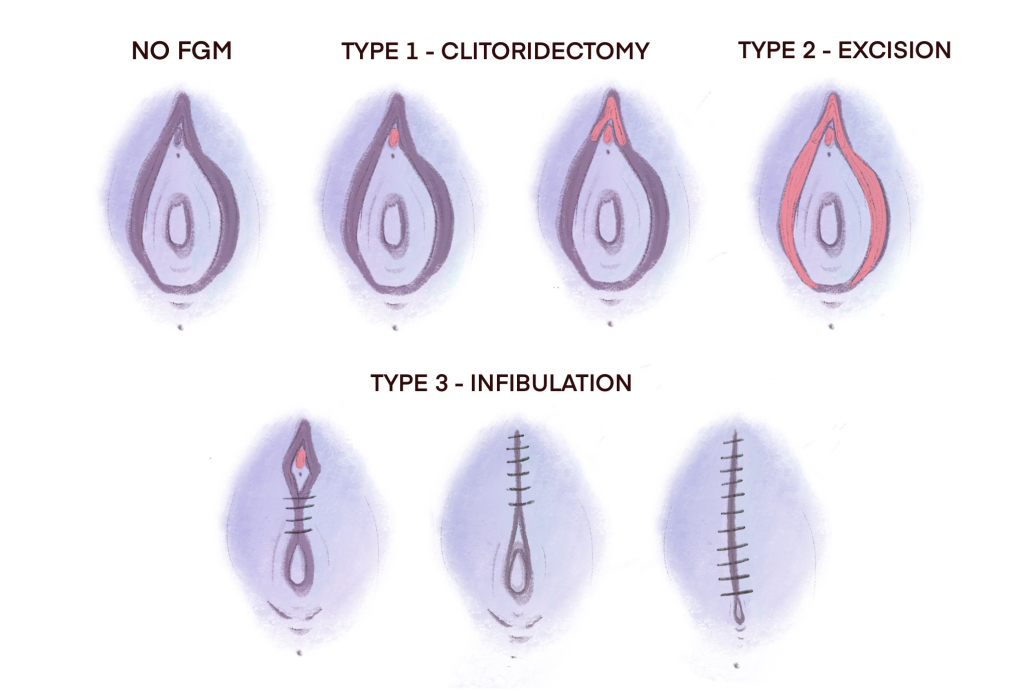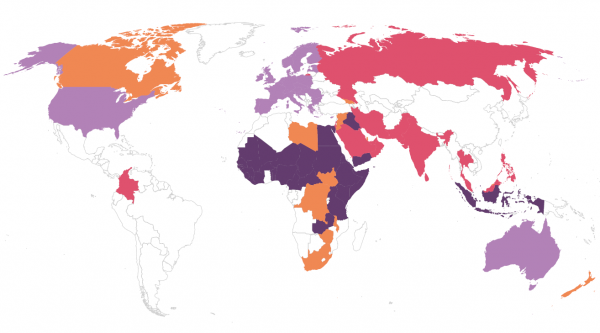According to the World Health Organization (WHO), Female Genital Mutilation (FGM) is defined as “all those practices that involve the total or partial removal of the female external genitalia or other injuries to the genital organs, whether for cultural reasons , religious or for any other non-therapeutic reason.
Types of Female Genital Mutilation
The World Health Organization has classified four types of mutilation:
- Clitoridectomy: partial or total removal of the clitoris (small, sensitive erectile organ of the female genitalia) and, in very rare cases, only of the prepuce or clitoral hood (fold of skin that covers the clitoris).
- Excision: partial or total removal of the clitoris and labia minora, with or without excision of the labia majora.
- Infibulation: narrowing of the vaginal opening to create a seal by cutting and repositioning the labia minora or major, with or without removal of the clitoris.
- Other: all other harmful procedures of the external genitalia for non-medical purposes, such as piercing, incising, scraping, or cauterization of the genital area.

GM is a violation of human rights and an expression of gender inequality that affects girls and women. Generally, it takes place sometime between the girl’s birth and the age of 15. However, occasionally it is also practiced in adult women, and may coincide, for example, with the time of marriage or even after giving birth.
According to the World Health Organization, there are some 200 million women in the world who have undergone FGM and more than 3 million girls are at risk of being subjected to this practice each year.
Most of these cases occur in 30 countries, of which 22 are on the African continent, the Middle East and some areas of Asia. And due to migration, in Europe, USA, Canada, Australia, New Zealand or any other geographical area of destination. But not in all countries there is the same degree of prevalence, nor in each prevalent country does the entire population perform it, and if it does, not in the same way. For example, in Kenya it is practiced by specific ethnic groups and not by the entire population.
The rate of FGM is increasing as the world population grows. If the rate of FGM continues to rise, the United Nations Population Fund (UNFPA) estimates that 68 million girls will be affected by this practice between 2015 and 2030.
All types of female genital mutilation have negative consequences, both physical and emotional, but depending on the type and the conditions in which it is performed, its severity varies.
Some of the consequences are:
- Pain, bleeding, infection, tetanus, damage to nearby organs.
- Death risk.
- Difficulty urinating, urinary and gynecological infections
- Blood or sexually transmitted infections such as hepatitis and HIV
- Keloids and fibrosis
- Pain during sexual intercourse and/or absence of pleasurable sensation.
The psychological consequences (fear, panic, shame, depression and anxiety) are usually more hidden and, therefore, little or not treated at all, and yet they can last longer than the physical ones and harm women’s lives more.
Pregnancy and childbirth can also be seriously affected by the consequences of some FGM. For example, with tears or fistulas if the birth canal is very narrow, which may require caesarean sections. Perinatal and maternal mortality increases as the expulsion time of the baby is prolonged if it has not been surgically opened before.
The reasons why FGM is practiced are very varied, but in all of them there is the common factor of control of the body and sexuality of girls and women. Some of these reasons are:
- Social Motives : It is a way to initiate girls into adult life. If the girl is not “cut” it may happen that no one wants to marry her or that society rejects her.
- Reasons in defense of tradition: to reaffirm itself in the community and not lose identity traits.
- sexual motives The control of female sexuality is recurrent, to eliminate their sexual desire, guarantee virginity and fidelity and limit the sexuality of women at the service of men.
- Health-related reasons : in some ethnic groups there is a belief that “cut” women are more fertile and that cutting improves childbirth.
- Reasons related to beauty, hygiene, purity. It is associated with the idea of purification because it is thought that the genitals are something ugly, dirty and that, therefore, a cut woman is a purer and cleaner woman.
No religion endorses FGM and it is practiced by Muslims, Christians and Jews alike, although the majority of practicing communities are Muslim. It is a cultural practice that, over time, has become a tradition.
It is a global phenomenon that is banned in 44 countries. However, it continues to be practiced underground and some communities avoid legal repercussions by engaging in cross-border FGM, a type of practice where girls living in a country where the tradition is prohibited are moved to another country where it is not illegal.
Female genital mutilation is directly linked to forced marriage as most girls who are mutilated are considered ready to marry, regardless of their age or personal desire.
